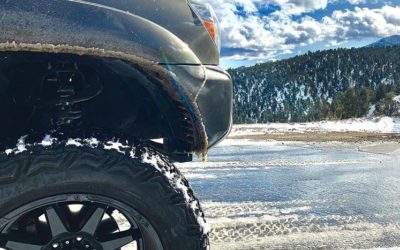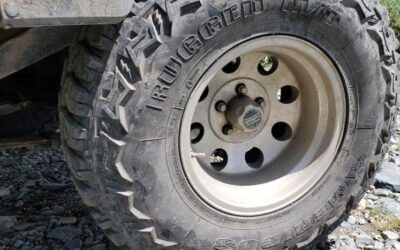Cracked and Bulging tires usually comes from hitting something. Under-inflation and over-inflation put tires at a greater risk of damage from impacts. Large cracks in the sidewall that runs along the rim are either impact-related or caused by chronic under-inflation. Many small cracks in the sidewall or tread blocks come from exposure to the elements and age. Rubber, much like your leather interior needs treating to prevent cracking, by using a tire and rubber protectant. Bulging is what looks like a pimple in the tire, most often in its sidewall. It happens when there’s an impact that causes internal damage, but the damage doesn’t show up until weeks or months later. With bulging, you’re looking at buying a replacement and the tire should be removed from service, regardless of the cost. Eventually, it will fail.
Feathered tread blocks are shaped like a series of ramps in a directional wear pattern that goes sideways across the tire. The lower edges of the ramps are rounded while the higher edges are sharp. If you can’t tell by looking, run your hands across the tread blocks. The Diagnosis: Most often, feathering means the car’s toe setting (a measure of the car’s alignment) is off. If the toe setting is correct, a worn or damaged suspension bushing could be causing the car’s alignment to shift as you drive. Check for worn or damaged ball joints and wheel bearings as well.
Tire Cupping happens when worn or damaged suspension components cause the tire to bounce as it travels, coming down harder on some spots of the tire than others. Bad shock absorbers are the usual cause, though anything that connects the wheel to the rest of the car could be a culprit. Be careful with your diagnosis, though. Even tire shops sometimes incorrectly identify feathering or heel-toe wear as cupping. A wheel that is out of balance may also cause cupping or bald spots to form, though there will be fewer hills and valleys than you’d see with cupping caused by a failed shock absorber.
For More Technical Tire Information visit:
Follow us on our Social Media as well.
Cold Weather Tire Tips
With the first official day of Fall behind us, much of the U.S. is seeing cooler temperatures. What does that mean for your tires and why does the low tire pressure symbol always come on during this time of year?
Plus Sizing Tires
Plus sizing, in the simplest terms, is when the size of the tire and/or wheel is increased from the original size put on the vehicle by the manufacturer. Plus sizing tires can dramatically change the look and stance of your vehicle and if done correctly no change to the Engine Control Module (ECM) would be required.
How Do You Find The Correct PSI Needs For Your Car?
Finding the right amount of PSI (PSI definition: PSI is a unit of pressure expressed in pounds of force per square inch of area. It stands for Pounds per Square Inch) for your tires can sometimes be tricky. You want to make sure this is as accurate as possible. Never Inflate your tire.




